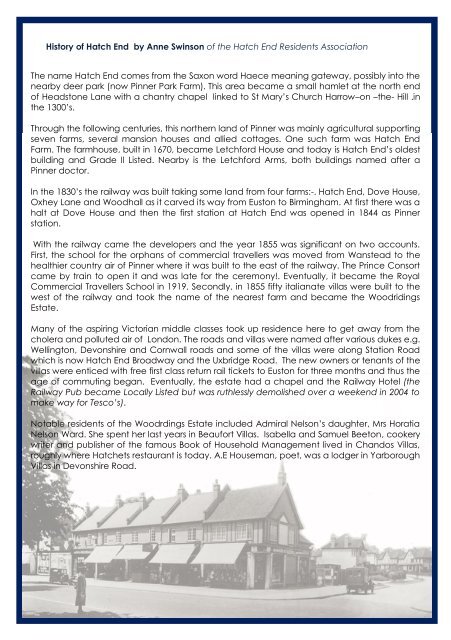The Hatch End Trade Association
The Hatch End Trade Association
The Hatch End Trade Association
You also want an ePaper? Increase the reach of your titles
YUMPU automatically turns print PDFs into web optimized ePapers that Google loves.
History of <strong>Hatch</strong> <strong>End</strong> by Anne Swinson of the <strong>Hatch</strong> <strong>End</strong> Residents <strong>Association</strong><br />
<strong>The</strong> name <strong>Hatch</strong> <strong>End</strong> comes from the Saxon word Haece meaning gateway, possibly into the<br />
nearby deer park (now Pinner Park Farm). This area became a small hamlet at the north end<br />
of Headstone Lane with a chantry chapel linked to St Mary’s Church Harrow–on –the- Hill .in<br />
the 1300’s.<br />
Through the following centuries, this northern land of Pinner was mainly agricultural supporting<br />
seven farms, several mansion houses and allied cottages. One such farm was <strong>Hatch</strong> <strong>End</strong><br />
Farm. <strong>The</strong> farmhouse, built in 1670, became Letchford House and today is <strong>Hatch</strong> <strong>End</strong>’s oldest<br />
building and Grade ll Listed. Nearby is the Letchford Arms, both buildings named after a<br />
Pinner doctor.<br />
In the 1830’s the railway was built taking some land from four farms:-. <strong>Hatch</strong> <strong>End</strong>, Dove House,<br />
Oxhey Lane and Woodhall as it carved its way from Euston to Birmingham. At first there was a<br />
halt at Dove House and then the first station at <strong>Hatch</strong> <strong>End</strong> was opened in 1844 as Pinner<br />
station.<br />
With the railway came the developers and the year 1855 was significant on two accounts.<br />
First, the school for the orphans of commercial travellers was moved from Wanstead to the<br />
healthier country air of Pinner where it was built to the east of the railway. <strong>The</strong> Prince Consort<br />
came by train to open it and was late for the ceremony!. Eventually, it became the Royal<br />
Commercial Travellers School in 1919. Secondly, in 1855 fifty italianate villas were built to the<br />
west of the railway and took the name of the nearest farm and became the Woodridings<br />
Estate.<br />
Many of the aspiring Victorian middle classes took up residence here to get away from the<br />
cholera and polluted air of London. <strong>The</strong> roads and villas were named after various dukes e.g.<br />
Wellington, Devonshire and Cornwall roads and some of the villas were along Station Road<br />
which is now <strong>Hatch</strong> <strong>End</strong> Broadway and the Uxbridge Road. <strong>The</strong> new owners or tenants of the<br />
villas were enticed with free first class return rail tickets to Euston for three months and thus the<br />
age of commuting began. Eventually, the estate had a chapel and the Railway Hotel (the<br />
Railway Pub became Locally Listed but was ruthlessly demolished over a weekend in 2004 to<br />
make way for Tesco’s).<br />
Notable residents of the Woodrdings Estate included Admiral Nelson’s daughter, Mrs Horatia<br />
Nelson Ward. She spent her last years in Beaufort Villas. Isabella and Samuel Beeton, cookery<br />
writer and publisher of the famous Book of Household Management lived in Chandos Villas,<br />
roughly where <strong>Hatch</strong>ets restaurant is today. A.E Houseman, poet, was a lodger in Yarborough<br />
Villas in Devonshire Road.<br />
hatchendtrade.com


